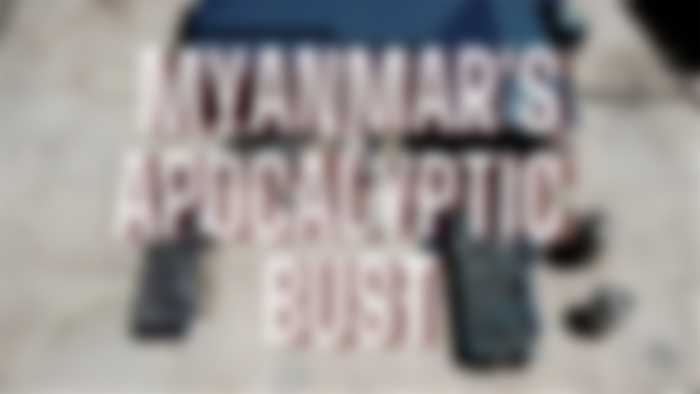We write about busts nearly daily. 1 million yaba tabs here, 30 kilos of ice there. You ain't seen nothing yet.

$11,956,150,000.
Eleven billion, nine-hundred fifty-six million, one-hundred and fifty thousand US dollars.
That’s the estimated street retail value of the 18-tons of drugs and precursors seized in a historic Burmese bust in the early months of 2020. It went down in northern Shan State, at the upper edge of the storied Golden Triangle. The mysterious, conflict-ridden zone that for decades has been known for its narcotics production.
So, did you hear about this bust? I’d wager not.
Compare this to the headlines out of Thailand in November, 2020, that touted an unrelated bust: a 11.5 ton, 30 billion baht ketamine haul out of an abandoned warehouse just east of Bangkok in Chachoengsao province.
Oops, scratch that. Publish a correction.
Reports came in a few days after the epic Thai bust that got even us scratching our heads. Just so happens that the Thai police seized a whole lot of nothing. Detergent, it later came out. That’s the truth about the piles of white stuff found sitting in the warehouse in Chachoengsao.
The Thai bust made international headlines. BBC, The Guardian, The New York Times all ran the story. And then ran the correction.
Big oof.
Now don’t get me wrong. If you ask me off the record that bust in Thailand is fishy.
How could you get something so wrong?
Was it just a case of an official jumping the gun on the news to make himself look good without verifying what he had on his hands? That seems to be the simplest answer.
Maybe human error.
Maybe not. We’re not here to decide.
Now, back to those 18 tons found in Shan State.
Turns out this stuff was the real McCoy. The whole kit and caboodle was independently lab-tested in Myanmar, and by the UNODC (United Nations Office on Drugs and Crime).
The whole lot was valued at about $12 billion.
A figure that makes even our eyes pop like a sweet hit of yaba at 2AM.

It’s a hefty sum and the drugs seized broke down as follows:
193,550,000 yaba tabs (17.4 tons of meth)
500kg of crystal meth
630kg of ephedrine
3,748 liters of methyl fentanyl
292 kg of heroin
588 kg of opium
49 kg of morphine
6.8 kg of ketamine
precursor chemicals totaling 41 tons and pre-precursor chemicals of 160 tons.
Pore over that tally again and you’ll find the familiar crew of South East Asia narcotics. But you’ll spot one difference if your eyes are trained and familiar with the region’s narcotic production.
Find it yet?
The 3,748 liters of methyl fentanyl.
Enough to produce billions of doses.
Enough to kill 100’s of millions of people with overdoses.
Methyl fentanyl is a synthetic opiate that has an analgesic effect multiple times that of normal fentanyl, and many more multiple times greater still than bog-standard heroin.
It’s the stuff that hit the American streets hard in the 2010’s. The stuff that kills 1 in 10,000 people in the USA. Tens of thousands of fiends on their final nod litter the American landscape because of this stuff.
That’s fentanyl.
Until this apocalyptic bust in 2020, the stuff barely existed in South East Asia. Fentanyl was always pumped out of industrial chemical factories in China.
But if 2020’s taught us anything, it’s to expect the unexpected.
Our prediction?
Things are about to change, fast and hard.
Here’s the story of the bust, as far as we can surmise. It’s not finished yet. These might just be the first chapters. But it’s a damn good start.
The bust puts Kutkai Township on the map

Dawn broke on February 9th, 2020.
Kutkai Township was blistered by nippy air.
A fog billowed into the valley. An ashen mass that blanketed the farms and villages that are peppered along the spindly and ancient unnamed roads.
Farmers get up and at ‘em early to feed the pigs. A fistful of sticky rice will hold the men over until noon. They labor hard here, eking out a humble existence in this overlooked corner of the world.
The Loi Sam Sip (“One Hundred and Thirty”) mountain range dominates here. Its crags and peaks burst up from the ground and hog the horizon’s view. This northern corner of the province is chock full of vistas fit for a respectable coffee-table book.
Other senses are activated here, too.
The smells.
The effluvia have no name, but their recipes are crystal clear.
Busy chemists, imported from more educated and advanced countries like China, cook meth in massive labs that feed the addicts in the region and beyond. Your nose is hit first with an acrid punch, then cut with a sharp sweet smell that betrays the poison, finally clobbered with an ugly sulfurous odor. They’re cooking meth. And lots of it.
It’s joined by another smell. A new one. Fentanyl. A strange chemical saccharine fume that fills the air above the villages and through the valleys of northern Shan State.
Then you hear it. Pop-pop-pop, pop-pop. Gunshots in the distance.
Drug kingpins, warlords, and the Tatmadaw - Myanmar’s armed forces: take your pick, it could be any of them firing.
If you’re a peasant here, hide your kids. They’ll come knocking around to conscript your sons, no matter their age, and gussy them up in fatigues and shove an assault rifle in their arms. Cart them off, never to be heard from again.
Your daughters? Well, I’ll leave that to your imagination.
This is the scene, Kutkai Township.
A conflict-ridden zone that is difficult to penetrate and dangerous to report from.
Very few venture here. The ones that do, the foreigners, mostly come on assignment. They’re the skilled labor, technicians and scientists, the brains behind the lucrative and booming drug trade.
It was 10 degrees centigrade that morning.

Cold as a witch’s tit when your home doesn’t have insulation.
The raids were conducted under Operation Golden Triangle 1511, a joint initiative involving six regional countries: China, Myanmar, Laos, Cambodia, Vietnam, and Thailand.
The aim? Squash illicit drug production in the Golden Triangle.
How successful this operation was can be debated. After all, tens of billions of dollars in narcotics are produced and smuggled out of these shady hills.
But in this particular case, on this particularly cool morning, the operation hit a jackpot.
The biggest drug bust in Asian history. That’s on the record.
A hair short of $12 billion retail value in product and chemicals. The same amount of yaba was seized in this bust alone than the previous 2 years in Myanmar combined.
To give further perspective, American customs agents seized 31 kilograms of fentanyl in 2015, then a whopping 1,154 kilograms in 2019.
But these busts can’t compare to the one in Shan State, which netted 3,700 liters of methyl fentanyl, a synthetic version of fentanyl that's even more potent.
This one bust dwarfed years of effort in America and Myanmar.
There were reportedly 130 arrests over the next month and a half that were directly connected to the busted facilities. But there's no word or widely publicly available info on who was arrested. We only know that many were not Burmese or Shan State nationals. Many likely came over from China as chemists.
The region has seen an explosion of drug manufacturing activity, even more so than recent years.
Part of this is due to crackdowns on production facilities in neighboring China. It left an open field of opportunity for somebody to come in and start making fentanyl again. Powerful syndicates like the Sam Gor moved into the region to fill the vacuum of production.
Trump and Xi Jinping shake hands.

The crackdown in China stemmed from an agreement that Trump and Xi Jinping made. In late 2018, the two leaders met in Buenos Aires at the G-20 summit. After the meeting, the White House sent out a statement that said, "President Xi, in a wonderful humanitarian gesture, has agreed to designate fentanyl as a controlled substance."
This changed the whole game. Here's the timeline of what followed.
Six months after the G-20 summit, China followed through with their promises.
The fentanyl factories were largely shuttered, according to reports. That takes us to mid-2019. The wild west of fentanyl production and logistics networks were squashed in China.
Fast forward another 6 months to the beginning of 2020 when we see the biggest drug bust in Asian history.
Along with it, a big flashing red warning sign of what's to come: fentanyl production has simply shifted to the rough-and-tumble hills of Shan State.
The move makes complete sense.
What happens from here is speculative but we can make some educated guesses: distribution and sale of fentanyl will ramp up in South East Asia, something we haven’t seen on a large-scale.
This will be devastating, as addicts drop like flies from overdoses on the rain-soaked sois of Bangkok to the dusty alleys of Manila, and law enforcement chases the money-hungry syndicates that make it all happen.
Shifting alliances, stacking cash

There’s a whole lot of money to be made in Shan State.
Big investors are in on the game. One goes by the name of Zhao Wei.
A Chinese casino and logistics mogul who’s building massive infrastructure projects like ports and casinos in the Golden Triangle Special Economic Zone. A chunk of land that hugging Mekong River that the Laos government handed over to China in 2007.
The US State Department unleashed economic sanctions against Zhao a couple years back. They froze the assets and accounts that they could, and made it very difficult for Zhao to transact personally or through his front operation, the infamous and seedy Kings Romans Casino.
But it takes a lot more than powerful kingpins to keep the drugs flowing out of Shan State.
That is to say, this industry isn’t a house of cards.
It’s run by a robust, tightly-woven patchwork of strange alliances whose motives might cross on one stitch, but overlap in the next when dollar signs flash in their eyes and the cash stacks up before them.
The labs in this region have been well-known for some time by Myanmar’s government, the United States DEA, and Chinese intelligence groups.
But nothing was done about it.
Why?
The whole racket is closely guarded and protected by the militias that scour and roll over these verdant, narcotics-clogged hills.
The profit motive to keep the factories pumping out the goods is very, very high. Tens of billions in cash money: difficult to trace, easy to launder.
It’s money that finds its way into a lot of hands. A dizzying network of criminal syndicates, armed rebel factions, business enterprise, opportunists, and even Myanmar’s military, the Tatmadaw.
They all might be fighting for different causes, but they agree on one: protect the factories that litter the hillsides and spit out chemical gold.
Enter the Khaung Kha, the “people’s militia force.”

They’re also known as the Kachin Defense Army (KDA), a splinter group of the Kachin Independence Army (KIA), based in northern Shan State.
Their troops take their training seriously. They sport fatigues and operate in well-armed factions that tramp through the hillsides.
Their goal is singular: defend their land against rebels who want to take it from them.
The central government of Myanmar looks the other way. For years they tacitly supported the group, but provided no direct funding: no food, no munitions.
So how did the Khaung Kha fund their operations? By protecting the drug factories that operate in their territory. That’s Myanmar’s claim now, anyway.
The group denies any association with illegal narcotic manufacturing, distribution, or sale.
After the big bust went down in February 2020, the Khaung Kha publicly distanced themselves from the drug trade.
They were vehement in their denial. There was no proof that they were associated with the illegal drug enterprises that raked in tens of millions of dollars in profit.
The Myanmar central government and its strong arm of the Tatmadaw, once ambivalent towards Khaung Kha, didn’t see things the same way.
The dominoes started to fall for Khaung Kha very shortly after the big bust in Kutkai Township.
The Tatmadaw seized more than 1,000 weapons and detained leaders of the “people’s militia.” The operation was executed at the Khaung Kha militia’s village headquarters in Lwekham on March 26th, 2020. Led by the Tatmadaw’s 99th Light Infantry Battalion, the militia put up no resistance.
Brigadier General Zaw Min Tun, a Tatmadaw spokesman, stated publicly that the Khaung Kha militia was now suspected to be involved in drug trafficking specifically connected to the busts in the region.
Don’t worry, we’re handling it.

In the months following Myanmar’s crackdown on Khaung Kha, the messaging has been one of operational success: the actions of the Tatmadaw, now controlling the region, have eradicated drug production.
It’s an extraordinary claim. One that requires extraordinary evidence.
And because journalists largely ignore this region, with few notable exceptions; and because the Myanmar government is as transparent as a red brick; and because the Shan State is a hot mess of jungle, ethnic conflict, and lawlessness, we’re unlikely to ever see the evidence to support it.
Besides, this industry is not a house of cards. When one support beam’s taken out, it’s immediately replaced by another.
There’s a byzantine network of rebel groups and syndicates that operate here. The roster of militias is long and reads like a dossier that could be interchangeable from any war-torn region: NDA-K, KNPLF, MNDAA, Makman militia groups, various Lahu militias, Jakuni militia, the DKBA, the KIO/KIA, the KDA, SSA-N and more.
Some disbanded, some still operational.
All ready to cash in on the drug trade.
The fog rolls on.

The fog rolled into Kutkai Township before February 2020.
The factories and chemists were deployed in the months leading up to the historic bust.
Colonel Zaw Lin, head of anti-narcotics operation in Myanmar, stated that the fentanyl came in from a neighboring country.
Of course, he wouldn’t name which one.
Reuters reviewed Myanmar police documents and the evidence was crystal clear: most of the drugs, precursors, and equipment were shipped in from China.
This shouldn’t surprise any of us.
It doesn’t surprise me.
But it’s an omen for what’s to come.
Think of it like this.
China is cleaning up its image on the international stage. They don’t want to be associated with the fallout of hundreds of thousands of deaths in America and internationally when the world decides to wake up and confront the fentanyl holocaust.
Yes, that is what it is.
It’s complete and total devastation when the stuff hits the streets. One bad batch, and dozens can die in a small town overnight before police can issue a warning for all addicts to ditch their bags.
Up until now, the fentanyl holocaust has been largely limited to North America. The past five years has seen over 130,000 fentanyl overdose deaths there.
Read that again, but slower.
Over 130,000 fentanyl overdose deaths. From a drug that’s been knowingly manufactured and distributed under the auspice of the CCP.
Trump put a little pressure on China, and so in a predictable move, the operations moved out into the even wilder western lands of Shan State, Myanmar.
But the same players are involved.
The fentanyl never went away.
I’ll reiterate a few of my own conclusions, just so I’m on the record and clear.
First, these developments will bring the fentanyl holocaust to other regions that simply haven’t seen its devastation yet.
Europe, Australia, and South East Asia especially. The latter two regions are flooded with narcotics pumped out of factories in Shan State. The regional distribution networks already exist. Fentanyl will be seen very soon in these regions and the fallout will be tremendous.
Think: the swaths of villages across South East Asia, underserved by medical resources, will soon be drowned in unregulated fentanyl in the same way that rural America is.
Addicts in the streets from Bangkok to Manila, from Saigon to Yangon, will taste the devastating and cruel highs of fentanyl, cheaper and more abundant now than their old heroin fix, and the market will fiend for more.
Of course, the suppliers will be ready to step in and meet the market’s demand.
The fog is coming.
It’s an unstoppable thing.
The fentanyl will move into South East Asia, Australia, Europe.
You can’t fight it. You can’t shoot guns at it and make it go away. You can’t huff and puff and bluster and make it just evaporate into thin air.
That’s why my take is that this was an apocalyptic drug bust.
After this, the world will never be the same.
A special note for readers:
If you enjoyed this write-up, you’re in luck.
We’ll be putting out weekly long-form articles like this.
The topics we’ll cover will be diverse and varied, but mainly center around crime, drugs, and mysteries in Thailand and the Golden Triangle. We’ll keep the content fresh and always look to delight our growing reader base.
Only hard-hitting, fresh true crime writing straight out of the Golden Triangle.
At your service,
True Crime Thailand
References:
https://edition.cnn.com/2020/12/07/asia/laos-ban-mom-port-zhao-wei-intl-hnk-dst/index.htm
https://go.drugbank.com/drugs/DB01571
https://www.mmpeacemonitor.org/border-guard-force-scheme
https://www.drugabuse.gov/drug-topics/trends-statistics/overdose-death-rates
https://www.affirmhealth.com/blog/word-on-the-street-fentanyl
https://www.reuters.com/article/us-myanmar-drugs-exclusive-idUSKBN22U0Q8
https://www.pri.org/stories/2020-06-10/massive-asian-drug-bust-has-stirred-fentanyl-mystery
https://www.nytimes.com/2019/12/01/world/asia/china-fentanyl-crackdown.html
https://www.irrawaddy.com/news/burma/myanmar-army-seizes-shan-state-militia-chiefs-drugs-bust.html
https://www.irrawaddy.com/news/burma/shan-state-militia-aa-deny-links-lucrative-drug-trade.html








